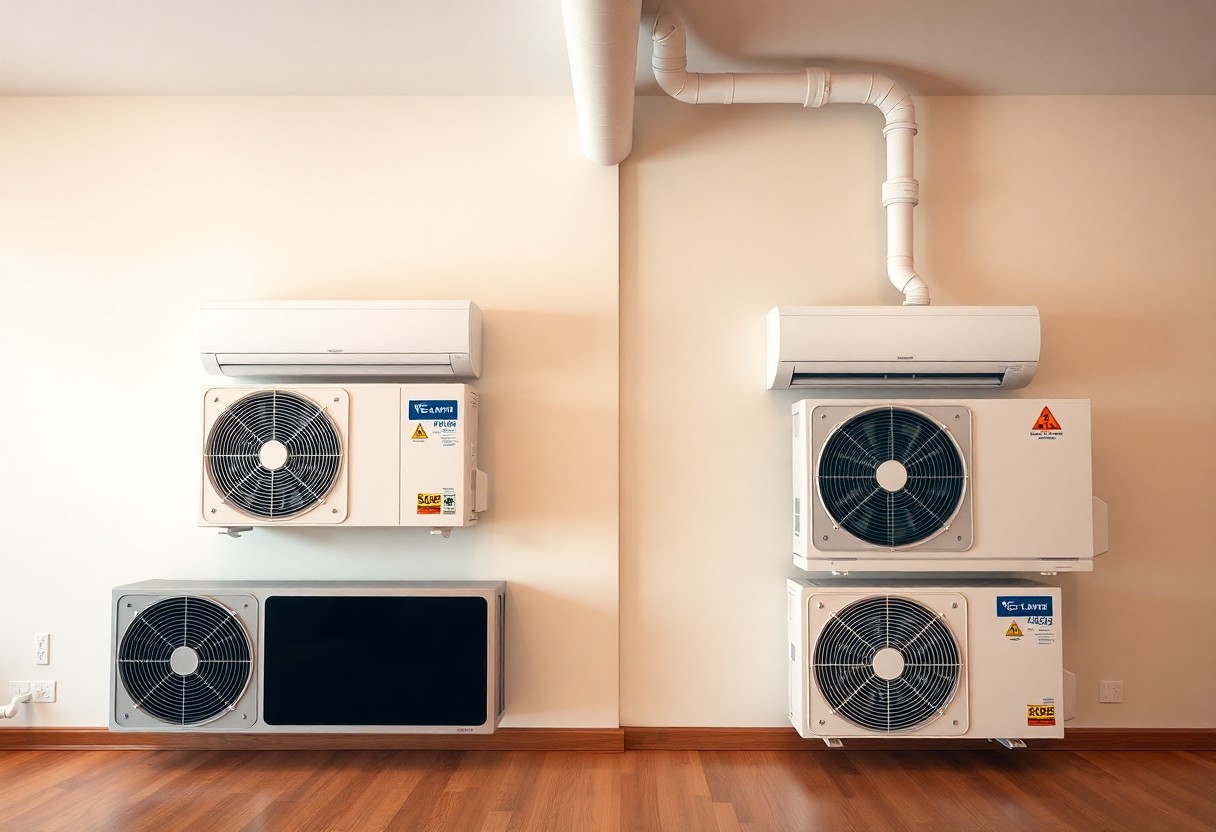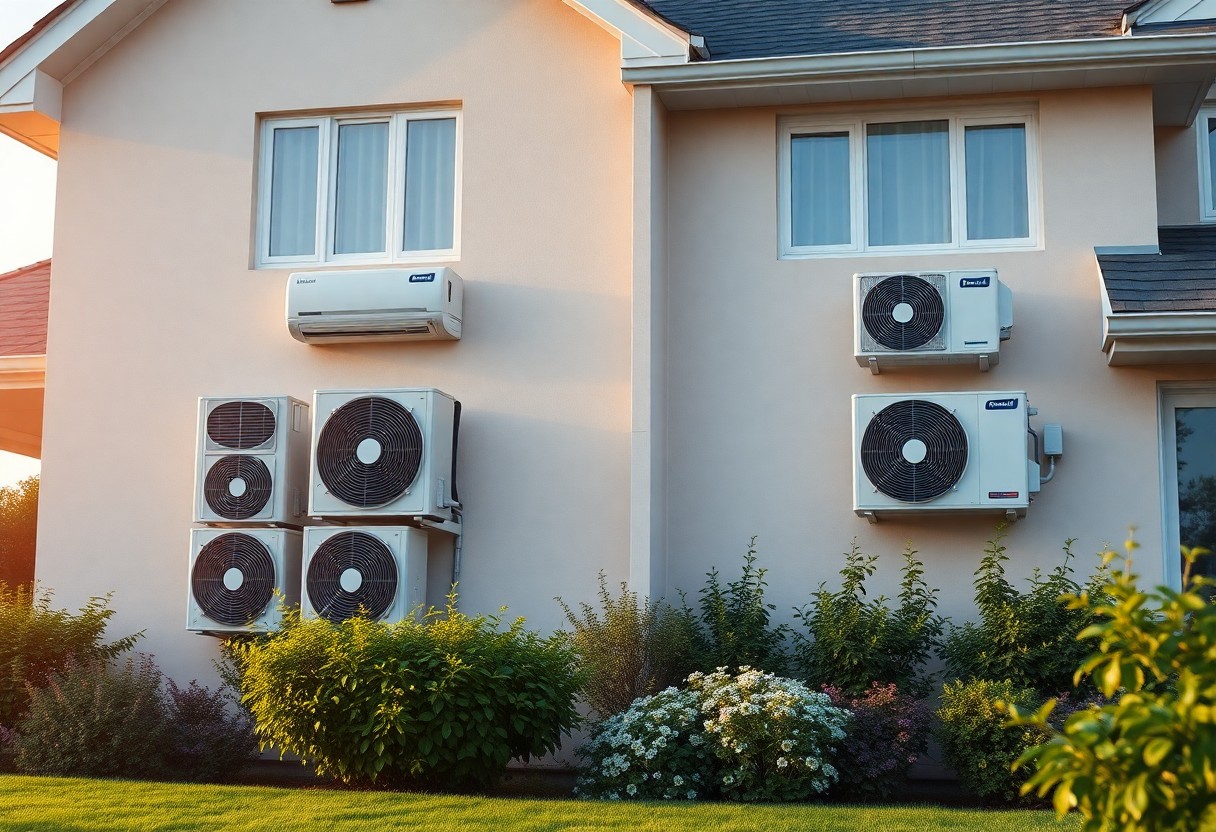It's vital to understand the differences between multi split and single split systems when considering HVAC solutions for your large home. Each option offers distinct advantages that can impact your comfort, energy efficiency, and installation requirements. By evaluating your specific needs and preferences, you can make an informed decision that meets your home's heating and cooling demands while optimizing performance and efficiency.
Key Takeaways:
- Multi split systems can service multiple rooms while using only one outdoor unit, saving space.
- Single split systems typically require more outdoor units, which can lead to increased installation complexity and cost.
- Multi split systems allow for individual temperature control in each room, enhancing comfort.
- Single split systems are generally easier to install and maintain, making them a good option for smaller spaces.
- Energy efficiency can vary; evaluate the specific requirements of the home and system type for optimal performance.
Decoding the Components of Split Systems
Understanding the components of split systems enhances your ability to make informed decisions for your home. Each system consists of an indoor unit and an outdoor condenser, which work together to regulate temperature effectively. Additional features like thermostats, air filters, and fans play a significant role in optimizing performance and energy efficiency, ensuring you get the most out of your investment.
Breakdown of a Single Split System
A single split system comprises one indoor unit and one outdoor unit, suitable for cooling or heating a single room. You can control the temperature directly from the indoor unit's remote or wall-mounted control. This simplicity lends itself to easy installation and maintenance, making it a practical choice for homeowners with a specific area needing climate control without complicated setup.
Exploring the Multi Split System Features
Multi split systems consist of one outdoor unit connected to multiple indoor units, offering the flexibility to control temperatures in various rooms independently. This configuration can save space and streamline your home's aesthetic by minimizing external units. With the ability to cater to different zones, you can optimize energy consumption, heating, and cooling for each area based on usage patterns.
The versatility of a multi split system means you can easily customize the temperature in different parts of your home. For instance, while cooling your living area, you might heat a bedroom simultaneously, catering to your family's preferences. These systems often include features like inverter technology, which adjusts the power based on the demand, leading to significant energy savings. Additionally, advanced filtration systems improve indoor air quality, making your living space more comfortable and healthier. With options for sleek designs, multi split systems blend seamlessly into home decor, elevating functionality without sacrificing aesthetics.

Efficiency and Performance: A Comparative Analysis
| Feature | Multi Split System |
|---|---|
| Energy Efficiency Ratio (EER) | Higher in varied conditions due to tailored climate control |
| Seasonal Energy Efficiency Ratio (SEER) | Generally better with multiple zones |
| Heat Pump Performance | More efficient in heating across larger homes |
| Operational Costs | Lower with long-term energy savings |
Energy Consumption in Varied Conditions
Multi split systems tend to optimize energy consumption effectively across different climates. By allowing zoning in your home, you can cool or heat specific areas without overworking the system, resulting in lower energy usage and reduced utility bills. In contrast, single split systems may lead to higher consumption when managing larger spaces due to their reliance on a single unit for entire areas.
Performance Metrics Across Different Spaces
Performance metrics such as cooling consistency and response time are significantly better in multi split systems. They can manage varying temperature preferences in different rooms, ensuring comfort without wasting energy. For large homes, individual unit controls enable you to pinpoint exact temperature settings suited to each space, while single split systems may struggle to reach desired temperatures uniformly, leading to discomfort and inefficiency.
The flexibility of multi split systems allows for precise temperature control tailored to the unique needs of each space. For instance, a bedroom may require a different temperature than a living area, and with individual controls, you can adjust settings seamlessly without affecting the entire home's climate. This targeted approach not only enhances comfort but also leads to greater energy efficiencies, as the system operates according to actual demand rather than outputting energy for unoccupied or less-used spaces, a common inefficiency in single split systems.
Installation Complexity: What Homeowners Should Know
Assessing the installation complexity is vital for making an informed choice between a multi-split and a single split system. Various factors can influence the installation process, including your home's layout, ductwork requirements, and the number of indoor units needed. Proper planning and consultation with HVAC professionals can streamline the process and ensure optimal setup.
Key Factors Influencing Installation Difficulty
Several elements can affect how straightforward or complex your HVAC installation might be. Consider these factors:
- Home layout and size
- Existing ductwork condition
- Number of indoor units required
- Location of outdoor unit
- Electrical capacity
- Local building codes
- Access to installation sites
- Potential need for additional refrigerant lines
- Availability of professional technicians
- Any unique architectural features
Pros and Cons of Each System's Setup
When choosing between a multi-split and single split system, it's vital to weigh their advantages and disadvantages carefully. The following table outlines key pros and cons for each system.
Pros and Cons of Each System's Setup
| Multi-Split System | Single Split System |
|---|---|
| Allows multiple indoor units | Lower initial cost |
| Energy-efficient for larger spaces | Simpler installation process |
| Individual climate control for each space | Less maintenance required |
| Minimal outdoor space usage | Higher running costs for larger homes |
| More complex installation | Limited capacity for larger areas |
| Potentially higher repair costs | Less flexibility in unit placement |
| Requires skilled installation | Standalone system per space |
| Customizable to your needs | Single temperature control |
| Quiet operation | Less suited for open floor plans |
| Any HVAC specialist can help you plan | Any single unit can be replaced easily |
Evaluating these pros and cons can help you determine which system aligns with your home's specific needs. Multi-split systems offer greater flexibility and efficiency for larger homes but may involve more intensive installation, while single split systems provide economical solutions for individual rooms with less complexity. Choose based on your budget, home configuration, and long-term HVAC needs.

Cost Considerations: Beyond Upfront Pricing
Upfront costs may not tell the complete story of your investment in heating and cooling. Factors like energy efficiency, potential rebates, and the longevity of the system contribute significantly to the total cost of ownership. Understanding these elements will help you evaluate options that align with your budget while ensuring comfort in your large home over time.
Long-Term Investment in Energy Savings
Energy-efficient systems often result in substantial savings on utility bills, which can offset higher initial costs. For instance, a multi-split system's higher SEER rating may save you hundreds annually compared to traditional units, leading to a return on investment that improves with each passing year.
Maintenance Costs: Predicting Future Expenses
Maintenance expenses vary widely based on system type, but neglecting regular upkeep can lead to higher repair costs and decreased efficiency. Budgeting for routine inspections and potential repairs is necessary to maintain optimal performance and longevity of your system.
Considering maintenance in your total cost equation is wise, especially for complex multi-split systems that often require specialized service. Annual maintenance can range from $150 to $300, depending on your location and system specifics. Staying proactive can prevent costly breakdowns; for example, regular cleaning of condenser coils can enhance efficiency by up to 30%. Assessing these future costs is vital for making an informed decision that ensures you won't be blindsided by unexpected expenses down the road.
The Lifestyle Factor: Comfort and Flexibility
The choice between a multi-split and a single split system ultimately hinges on your lifestyle needs and desired level of comfort. With different systems offering distinct features, the multi-split option allows for more tailored temperature settings across various rooms, catering to personal preferences and enhancing overall living experiences. A single split system, while simpler, may lack the versatility to accommodate diverse climate demands within a large home.
Tailoring Climate Control in Different Zones
Multi-split systems empower you to customize climate control in distinct areas of your home, creating comfort zones tailored to specific activities or family preferences. For instance, you can cool the living area while keeping bedrooms warmer, ensuring everyone enjoys their ideal atmosphere without compromising on efficiency.
Aesthetic Integration Into Various Home Designs
A multi-split system seamlessly blends into different home styles without dominating your interior aesthetic. Indoor units can be discreetly installed to complement contemporary decor or traditional designs, allowing homeowners to maintain their desired look while enjoying efficient heating and cooling solutions.
With a plethora of indoor unit styles available, ranging from wall-mounted to ceiling cassette options, you can choose designs that enhance your home's interior. For instance, sleek, minimalistic units work well in modern spaces, while classic styles fit into traditional settings. This flexibility means you can prioritize both functionality and stylish integration, ensuring your climate control system enhances rather than detracts from your home's aesthetic appeal.
Final Words
Drawing together the comparison between multi-split and single-split systems for your large home installation, you should consider your specific needs and preferences. Multi-split systems offer flexibility and efficiency, allowing you to control temperatures in different zones, while single-split systems may be simpler and more cost-effective for smaller areas. Ultimately, your decision should reflect your budget, energy efficiency goals, and the layout of your home, ensuring that you achieve optimal comfort and performance.
FAQ
Q: What is the main difference between a multi split system and a single split system?
A: A multi split system connects multiple indoor units to a single outdoor unit, allowing for different temperature controls in various rooms. In contrast, a single split system consists of one indoor unit paired with one outdoor unit, suitable for single-room applications.
Q: Which system is more energy efficient for a large home?
A: Multi split systems are often more energy efficient for large homes since they can effectively distribute air across multiple spaces, reducing energy waste compared to operating several single split systems.
Q: What are the installation considerations for multi split versus single split systems?
A: Multi split systems typically require more complex installation, including refrigerant lines for multiple units. Single split systems are easier to install as they only require one refrigerant line and are generally less invasive.
Q: Are there maintenance differences between the two systems?
A: Maintenance for both systems is similar in terms of routine cleaning and servicing. However, multi split systems may require more frequent servicing due to multiple indoor units, which can complicate maintenance schedules.
Q: How do the costs of multi split systems compare to single split systems?
A: Initial costs for multi split systems tend to be higher due to more equipment and installation complexity. However, the long-term savings on energy bills and potential for multi-zone comfort can offset these upfront costs.

